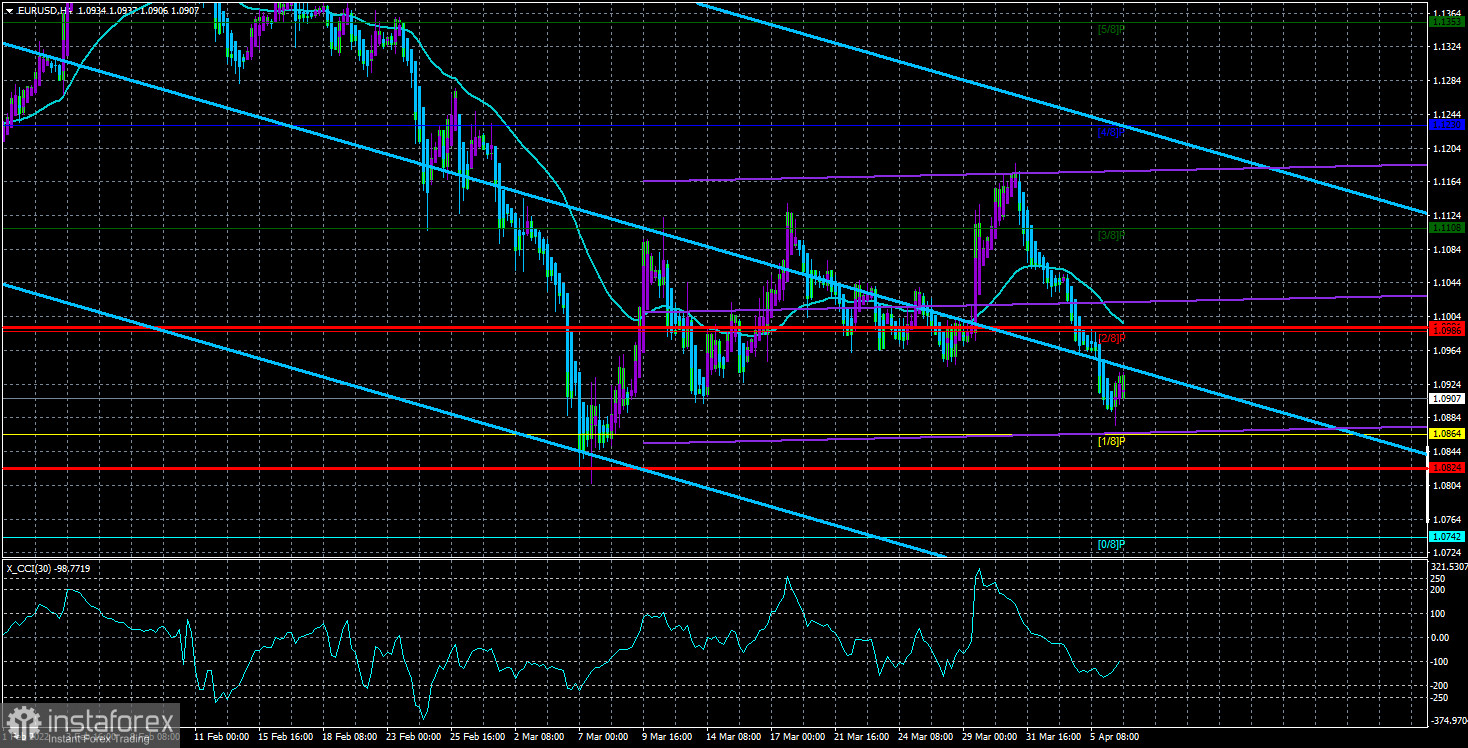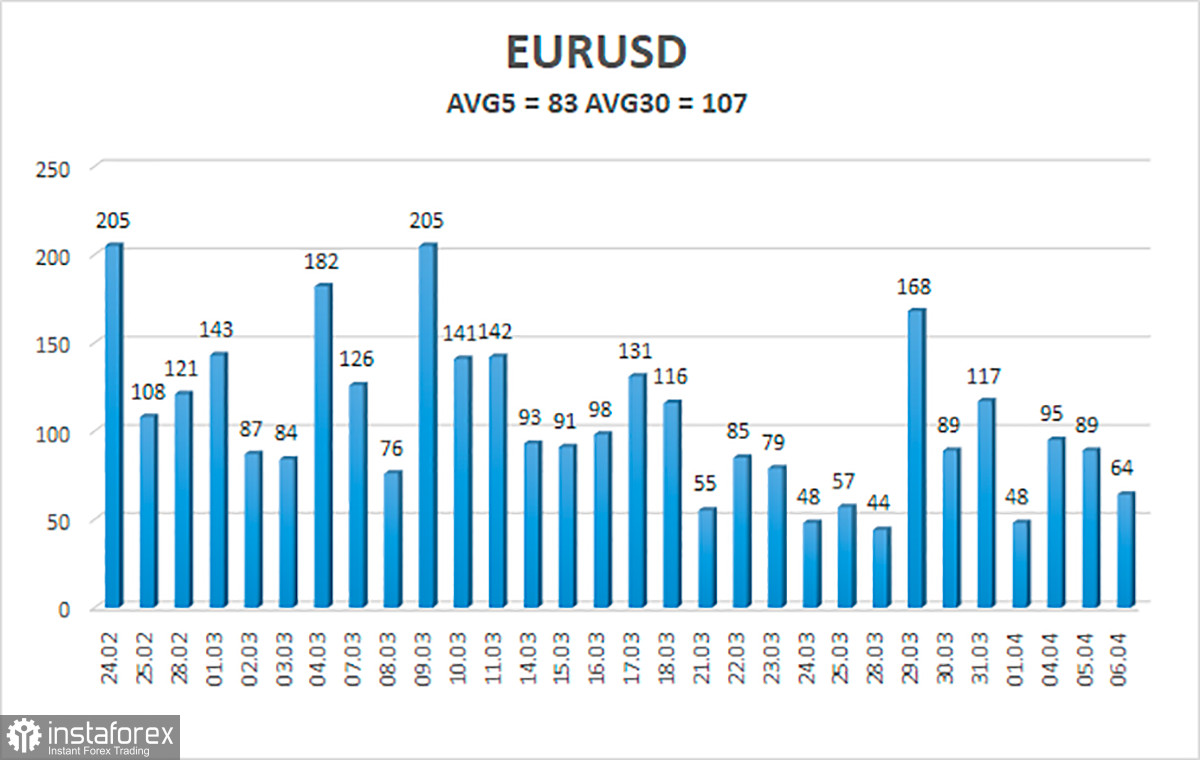
The EUR/USD currency pair calmly continued to fall on Wednesday, if we look at the trend at least in the medium term. The minimal pullback that the pair showed during the day does not even pull the concept of "pullback". Quotes moved away from the lows of the day by 50-60 points. That is, formally, a round of upward correction may begin now, but so far all factors speak in favor of continuing the fall of the European currency. In principle, we have already analyzed dozens of times why the fall of the euro is now the most likely scenario. There is not a single more or less worthwhile factor in favor of the growth of the euro currency now. Therefore, by the end of the year, we may well see price parity between the euro and the dollar. At the moment, the quotes are very close to their local lows, and we believe that this week the pair may go below them. Even the junior linear regression channel has started to turn down again, although it has been directed upwards in recent weeks. What do we have as a result?
The monetary policies of the ECB and the Fed are now at different poles. And not in favor of the ECB. The Fed's rhetoric is tightening every day, and the ECB's rhetoric remains ultra-soft. The geopolitical conflict in Ukraine is moving into the "Donbas 2.0" stage, and the fighting seems to be focused on the Donbas again. After it failed to take either Kyiv or Kharkiv, Russian troops were redirected to the Donetsk and Luhansk regions and, most likely, will try to expand the borders of the so-called LPR and DPR. That is, the military conflict has not been completed and will continue, just on a smaller territory and with much more modest goals of the Kremlin. And the non-improving geopolitical situation does not allow the most risky currencies like the euro or the pound to rise in price against a stable dollar.
Further, the European economy is now a klondike of problems. Not only did it show "mind-blowing" growth of 0.3% in the fourth quarter before the Ukrainian crisis, but also the events of recent months have successfully finished it off. First, there is huge pressure on the European budget now. The European Union is actively sending weapons, humanitarian aid, and financial assistance to Ukraine. That is, it incurs serious expenses for the support of Ukraine. Second, several million people have left Ukraine for the EU countries, who need to be accommodated, helped, paid benefits, and subsidies. The sanctions war of the West against the Russian Federation hits the EU economy the most. The states are far away and do not depend on Russian hydrocarbons or the economy in any way. But the European Union is very dependent. Therefore, any rise in the price of these very hydrocarbons leads to a wild increase in prices for almost everything. Washington continues to put pressure on Brussels on the issue of a complete oil and gas embargo, and every new event in Ukraine only brings the moment when it will be imposed closer. Although all EU countries understand the consequences of a complete rejection of Russian energy carriers, only three countries openly oppose the embargo: Austria, Germany, and Hungary. The rest of the EU members allow such a move.
A new package of sanctions against the Russian Federation has been introduced!
Just yesterday, it became known that a new package of sanctions, which was announced earlier this week by Ursula von der Leyen, has been introduced. This means that now no Russian vessel will be able to enter a European port, 4 more banks have been disconnected from the SWIFT system, a complete embargo on coal imports from the Russian Federation has been imposed, restrictions have been imposed on the export of certain groups of goods and equipment to Russia and imports from Russia. What does this mean? This means that all business ties between the Russian Federation and the European Union continue to break off. No sooner had the European Union approved the fifth package of sanctions, than Ursula von der Leyen announced a new sanctions package, which may include the introduction of duties on oil and gas imports from Russia. This will mean that hydrocarbons will cost even more than they do now, which will make it unprofitable to purchase them in Russia. However, this will not stop the energy crisis that is coming to Europe. Even if you buy gas and oil at higher prices, you need to have places where you can buy them in such volumes. But there are no such places, and the euro currency is very sensitive to the impending storm.

The volatility of the euro/dollar currency pair as of April 7 is 83 points and is characterized as "average". Thus, we expect the pair to move today between the levels of 1.0824 and 1.0990. The upward reversal of the Heiken Ashi indicator signals a round of upward correction.
Nearest support levels:
S1 – 1.0864
S2 – 1.0742
S3 – 1.0620
Nearest resistance levels:
R1 – 1.0986
R2 – 1.1108
R3 – 1.1230
Trading recommendations:
The EUR/USD pair continues to be located below the moving average line. Thus, now we should consider new short positions with targets of 1.0864 and 1.0824 after the reversal of the Heiken Ashi indicator down. Long positions should be opened with a target of 1.1108 if the pair is fixed above the moving average.
Explanations of the illustrations:
Linear regression channels - help to determine the current trend. If both are directed in the same direction, then the trend is strong now.
Moving average line (settings 20.0, smoothed) - determines the short-term trend and the direction in which trading should be conducted now.
Murray levels - target levels for movements and corrections.
Volatility levels (red lines) - the likely price channel in which the pair will spend the next day, based on current volatility indicators.
CCI indicator - its entry into the oversold area (below -250) or into the overbought area (above +250) means that a trend reversal in the opposite direction is approaching.





















